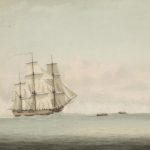With news of General Washington’s defeat in New York City, the threat of a British attack loomed over the city of Newport, Rhode Island during the summer of 1776, and by winter nearly half of the city’s population had fled. British reports from December 1776 noted that there was scarcely anyone remaining as British and Hessian forces seized Newport, allowing them to take the wealthy and strategic city without a fight.
For those residents who stayed, their circumstances quickly worsened as the occupying forces commandeered many of their homes, ate their food, and stole their valuables. Under the command of Major-General Richard Prescott, the soldiers robbed and dismantled properties across the city and, in the three years they were there, reportedly chopped down all but one tree for firewood to survive the unsympathetic winters.
The tide of the war had turned by the winter of 1778, though, as the French joined the American cause and sailed toward Newport to join up with the American forces. Alerted to the French Fleet’s movements, the British Navy began to scuttle ships in the outer harbor with the aim of slowing the advance of the French fleet. In the end, thirteen Navy and transport ships were deliberately sunk.
Now, 241 years later, archeologists are exploring the wreck of one of these sunken vessels hoping to identify it as the H.M.S. Endeavour, the ship captained by the famed Captain James Cook as he circumnavigated the world from 1768 to 1770. It was on this journey Cook claimed Australia for Great Britain, and the notes and observations of the accompanying team of naturalists led to significant advances in European scientific knowledge.
It was on this journey Cook claimed Australia for Great Britain, and the notes and observations of the accompanying team of naturalists led to significant advances in European scientific knowledge.
It is strange to think that such a famed ship lies forgotten at the bottom of Narragansett Bay. After its circumnavigation, the Endeavour was sold in 1775 and renamed Lord Sandwich. The ship was then contracted back to the British Navy to transport soldiers and supplies. In December 1778 the vessel was acting as a prison ship jailing American revolutionaries in Newport as the French Fleet made their approach.
In the summer of 2019, archeologists from the Rhode Island Marine Archaeology Project and the Australian National Maritime Museum mapped the wreck suspected to be H.M.S. Endeavour and confirmed it as one of the scuttled eighteenth-century ships. The excavation of the site has uncovered artifacts such as bits of leather, textiles, glass, ceramics, and gun flints, all of which further confirm the age of the wreck.
More work will need to be done to confirm the ship’s identity, but it is exciting to learn about the efforts underway in Newport’s harbor. This summer’s excavation uncovered only a small portion of the structure. Archeologists and researchers will work to compare what we know about the Endeavour, and how it was built more than 250 years ago, to the timbers of the wreck now sitting off Newport’s shoreline.
Share this:

About Danielle Cournoyer
Prior to NEHGS, Danielle worked as an Interpretation and Programming Fellow for The Church of the Presidents, where she led guided tours of the historic church and the Adams crypt. Additionally, Danielle has worked as an Historic District Research Aid for the Arlington Historical Commission. She graduated from the University of Massachusetts-Boston with a Master of Arts degree in History in May 2016. Her interests include urban development and history, focusing on Boston and New York.View all posts by Danielle Cournoyer →
